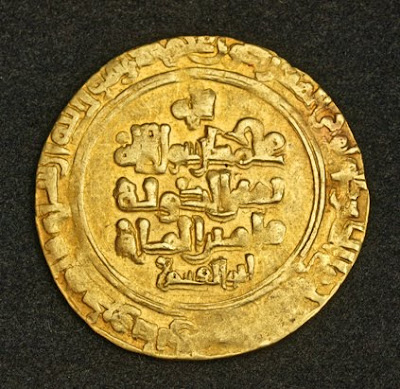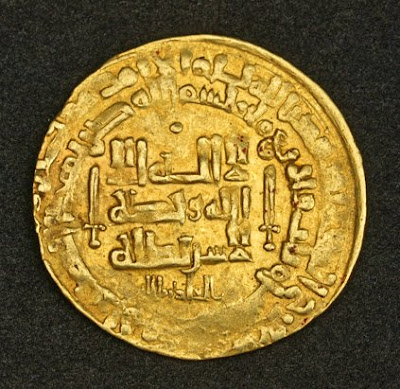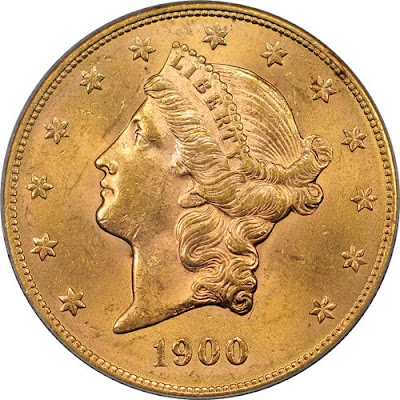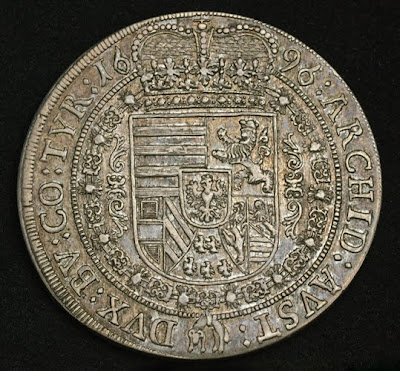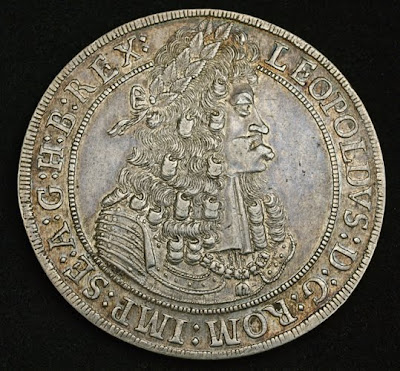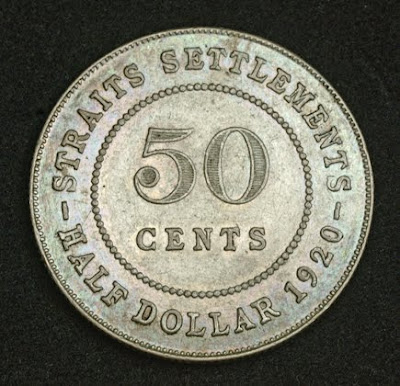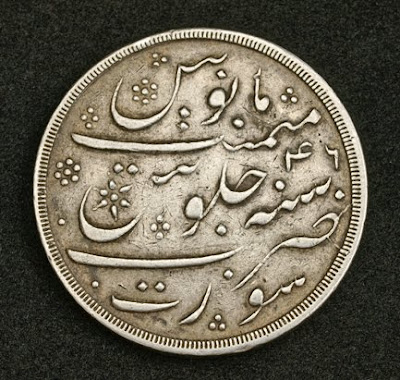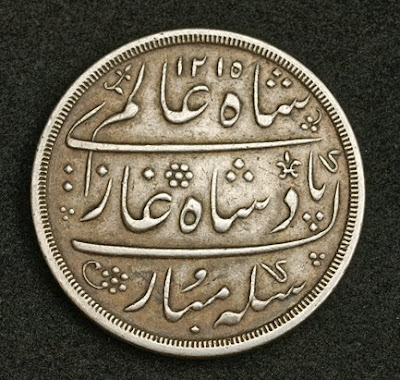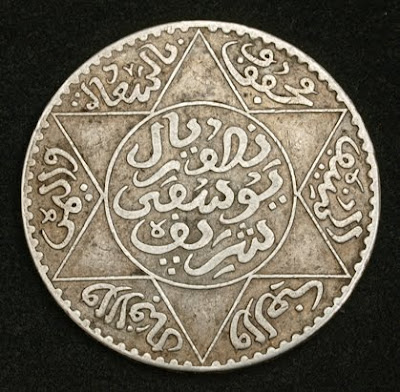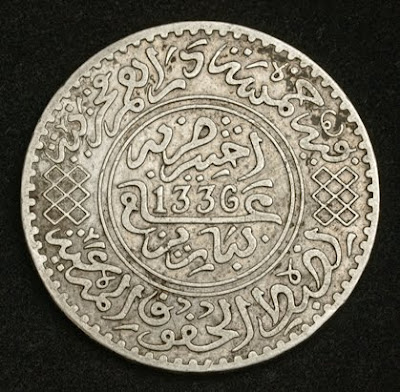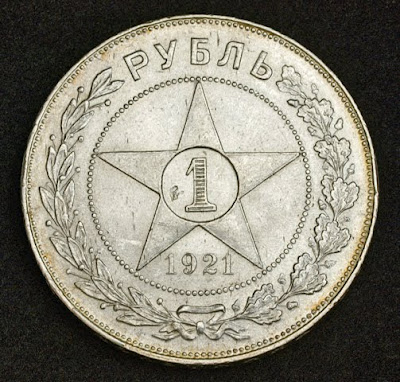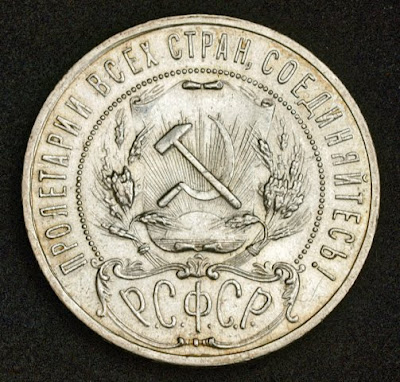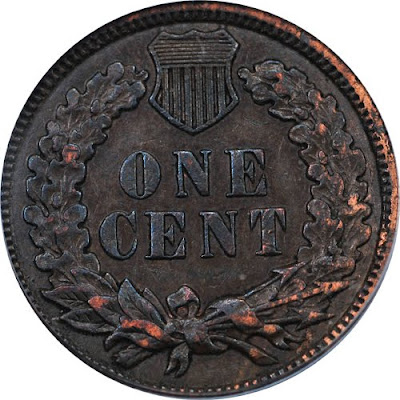Gabella. A silver coin of Bologna, issued
in the sixteenth century nnder Popes
Julius HI and Marcellus If. It appears
to have been a variety of tlie Carlino.
There is a double and a triple, tlie latter
also known as Gabellone.
Gabulus Denariorum. According to
Seld.Mi. Iflstorii of Tithes (321), this was
tiie lei/al t'ei-ni foi- rent jiaid in inonej'.
Ga-den Pho-dang Tang-ka. See Tangka.
Galeazzo. A silver coin of Venice
struck liy tlie Doge Alvise Pisani (1735-
1741 ) for Dalmatia and All)ania. It had
a value of tliree Lira, and halves and ipiarters
were also issued.
Gall. A former small silver coin of
Cambodia. See Kelly (p. 216).
Galley Halfpence. A name given to
half pennies of base metal and somewhat
thinner though larger than the regal issues.
The name is said to be derived from the
fact tliat they were brought from Genoa
by the galleymen who traded in London,
and a spot known as the Galley Key
(? quay), in Lower Thames Street, near
Tower Hill, was the locality from which
the.v were circulated.
They were declared fraudulent by Acts
of Henry IV and Henry X, init continued
to be brought into England until their
circulation was finally prohibited bv statute
in I.'')!!).
Gallus Pfennig. A billon coin of the
canton of St. (iallen, Switzei-bind, struck
by the abbots and by the civic authorities
dui-ing the fourteentii century. It resembles
tlie Bracteates in fabric and bears the
figure of a saint. See Blanchet (ii. 264).
Ganza. A former base metal coin of
i'.iiniia, consisting of cojiper and tin. It
is mentioned by a number of wi-iters early
in the nineteentii century as being e(iual
to two or three French Sous. It was abolished
about 1840 and the Kabean (q.v.)
succeeded it.
[
Gass. A denomination of Maskat, the
four hundredth part of the Piastre. See
Mahmndi.
Gastmael-Penning. See Labay.
Gazzetta. A copper coin of Venice
whicli was originally struck for the Gohmies
and later ado]ited by the city. Pieces
of one and two Gazzette were issued for
("andia about 1632, and Mailliet mentions
a piece of ten Gazzette struck during tiie
war against the Turks (1646-1650).
For Zante it was struck with the inscription
CORFV. CEFAL. ZANTE ; and for Zara the
pieces of two Gazzette have isole et ar-
MATA, or ARMATA ET MOREA.
It is claimed that the first newspaper
ever published, which was issued at Venice,
obtained its name from this coin, which
was the price of a copy, and from which
the English word "gazette" is derived.
The (iazzetta was issued for the Ionian
Islands as recently as 1801, when those territories
were under Russian protection.
Geburtstagsthaler, i.e.. Birthday Thaler,
is the name given to a large silver coin
struck in 1666 to commemorate the eightyeighth
birthday of August, Duke of Brunswick-
Wolfenbiittel. The obverse shows a
bust of the Duke in a wreath of laurel and
the inscription pavstum. ivstitae. et. pacis.
consortivm.
Gedachtjiismiinzen. See Jubileums Thaler.
Geeltje. A Dutch popular name for a
gold coin and derived from "geel," i.e.,
yellow. See Gelbvogel.
In some parts of Holland the term Geelvink,
i.e., "yellow-finch," is used for a
Ducat or any gold piece.
Gefiitterte Miinzen. See Plated Coins.
Gehelmde Leeuw. See Botdrager.
Gehelmdeschelling. A variety of the
Sclielling struck for the Low Countries at
the beginning of the seventeenth century,
which receives its name from the device of a helmet on the obverse. It was issued
chiefly in Deventer and Zwolle. See
Ileaunie.
Gelbvogel. The popular name in Southern
Gei'mauy for a gold coin. The word
means "yellow bird." See Geeltje.
Geld, the (rerman equivalent for money
in iiiMieral.
Gelegenheitsmiinzen. A term used both
for coins issued occasionally, and to commemorate
some special event.
Gelso, possibly a corruption of Guelfo
(q.v.). A term used in Verona to describe
coins of tive Soldi issued from circa 1349
to 1428.
Genevoise. The name given to the Repulilii-
an Thaler of Geneva issued in 1794.
Its value was twelve Florins, but upon the
adoption of a decimal system it was exchangeable
at ten Decimes.
Genovino. A gold coin of Genoa introduced
ill the twelfth century. The type
usually exhiliits a gateway on the obverse,
and a cross on the reverse, with the inscription
CONBADVX REX ROMANO. There
exist halves, thirds (Terzaroli), and quarters,
the latter i-eceiving the name of Quartarola.
The Genovino di Oro remained as
the current gold coin in Genoa until the
termination of the Sforza dynast}^
The Genovino di Argento dates from the
sixteenth century and was of the same
value aii]iroximately as the Scudo.
Gentil. See Dobra Geutil.
Genuini. See Janumi.
Geordie. See White Geordie and Yellow
( ieordie.
George. An English slaug term for
a coin bearing the image of St. George.
Grose, in his Dictionarii of the Vulgar
Tongue, 1785, has, "George, a half-crown
piece." See Decus (supra).
The English Guinea was popularly
known as a "Yellow George." Robert
P.uriis, in his Epistle to Rankine, 1784
(xii.), says, "An 'baith a yellow George
to claim."
George. Tlie name given to the fivedollar
gohl piece issued in Canada in 1912.
fi-om the fact that it bears the head of
(icorge V, King of England.
George Noble. A rare gold coin of
England wliicii appeared only in the second
coinage of Henry VIII, i.e., from 1526
when they were autliorized, to 1533 when
the divorce of Katharine of Aragon occurred,
the latter date being fixed by the
letters H and K on the obverse. It was
current for six shillings and eight pence,
and the half George Noble (of which only
one specimen is known) in ])roportion.
About four varieties of the Noble exist, all
having the rose mint mark. The reverse
legend is a (juotation from a hymn l>y Prudentius,
written in the latter half of the
fourth century.
Georgius Triumpho. A copper coin, of
the half-penny size struck in England in
1783, for circulation in the Colonies of
North America. The reverse bears a figure
of Liberty with the legend voce populi
(q.v.).
Georgsthaler. The name applied in general
to any coin of Thaler size on wliich
there is a figure of St. George slaying the
dragon.
There is an extensive series of them for
Mansfeld during the sixteenth century
and later, and they were also issued in
Hungary and in Hanover. See Florin-
Georges.
Gerah. An early Jewish weight standard
and equal to one twentieth of a Shekel.
See Exodus (xxx. 13), Leviticus (xxvii.
25), Numbers (iii. 47), Ezekiel (xlv. 12).
Gerefa. Among the Anglo-Saxons this
was the chief officer of the mint. See
Riuling (i. 15, 137).
Gerlacus. The name given to the gold
Gulden struck by Gerlach, Archbishop of
Mainz (134G-1371). An ordinance of circa
1400 states that this piece was of light
weight compared with the Ducat. See
Paul .Joseph (p. 214).
Gersh. Sec Ghrush and Guerche.
Gessnerthaler. A very rare silver coin
of Zurich, issued in 1773, and after tlurtysix
specimens were struck the dies broke.
It was designed by the painter and poet
Salomon Gessner, and the dies were cut
by Balthaser Vorster.
Gettone. The Italian etiuivalent of Jeton
(q.iK).
Geusenpfennige are not coins but small
medalets bearings the figure of Philip II
of Spain. After the compromise of Breda
.2]
Gewere Giustina
in 1.'>()() cortiiiii of tlio iioMos f)f the Low
('iiiiiitrics wci-c ((nitcniptuously rctViTcd to
as fiKcuj-, i.e., hc^pirs. They adopted this
nickname and issued tokens witli the inseription
en tout fidelles an roy. Tlie reverses
bore clasped hands and a befrj^ar's
bag with jiisques a porter la besace.
Gewere. Du Can^e eites an ordinance
of 12!t4 i-eading sub annuo ccnsu . . .
(Irnariorum Flandrinsium monetae quae
(licltur (jewere; but no such coin can be
i<h»ntified.
Ghost's Face Money, or Ghost's Head
Money. Sic Ant's Nose Coins.
Ghrush. A silver eoin of the Ottoman
Enipii-e. oriy:inally issued \inder Soleinum
11 (A. II. !()!)!)). The name recalls the (Iros,
(Troscheii, and (iroat, and by travellers it
was termed Piastre, whieli however must
not be confused with the modern eoin of
the same name.
The name of the coin is variously written
Grush, Onrush, Gersch, etc. The later issues
are of billon. See Asadi Ghrush and
Guerche.
Its value was forty Paras, and the issues
for E<;ypt in billon were equal to forty
Medins.
The modern E<i;yptian nickel coin of five
Jlilliemes is known as a Guer.sh.
Gianuino. The name given to a variety
of the silver Luigino {q.v.) of Genoa issued
in 1668 and later by the Banco di
San (iioi'gio, under Cesare Gentile. It has
on the obverse a crowned shield supported
by two griffins, and on the reverse a Janus
head with male and female faces.
Gigliato. An Italian word meaning
strewn or decorated with lilies. The name
was originally apjilied to a variety of the
Garlino {q.v.) issued by Charles II of
Anjou, King of Naples and Sicily (1285-
l.'iO!!). The reverse of this silver eoin
bears a shoi't cross suri'ounded with lilies.
Tiie tyjie was copied in Piedmont, Durazzo,
1).\ the Grand .Masters of the Order of
.^ialta, etc.
The Fioriid d'Oro of Florence bearing
the figure of a lily are also called by the
same name.
Gigliato d'Oro. Sec Lis d'Or.
Gigot. A copper coin of the value of
iialf a Liard struck at Antwerp, Mons,
[
Reckheim, Bois-le-Duc. and other |)laces in
Brabant dui'ing the sixteenth and seveuteentli
centuries.
Gildepenningen. Tlie conunon name for
the tokens formerly is.sued by the numerous
guilds in Holland.
Gin Kwan. Early .lapanese silver ring
money (q.v.). The word "Gin" in .lapanese
means silver.
Ginocchiello, meaning a "Knee-piece,"
was the common name used in Venice in
the fourteenth century for a variety of
the Soldino which boi'e a figure of the
Doge in a kneeling position. See Pa|)adopoli
(i. ix. 14).
Giorgino. A billon coin of Modena issued
l)y Cesare d'Este (1.597-1628) and
continued until the middle of the eighteenth
century. It has a portrait of St.
Gerainian on the reverse. See Luigino.
Girasoli. A nickname or popular name
for the silver coin of 160 Sols struck al
Mantua when that city was besieged by
the Emperor Ferdinaiid II in lGL'!l-:{(').
The name means a sunflower and both of
these objects are depicted on the coin. See
Mailliet (Ixxviii. 2).
Giulio. A Papal silver coin, which under
the name of Grosso Largo was introduced
in the thirteenth ccntui-y. and I'cceived
its more common designation from
Pope .lulius II (150:Mr)l:!). In a tract
entitled ^1 Miffiinus fa the Jubilee at li'ome,
1625, it is said to be worth eight Soldi.
It was copied at Guastalla under Cesare
Gonzaga (1570-1575); at Avignon under
Gregory XIII and his successors; at Camerino,
Mantua, etc.
Giustina. Tlie name given to a \'enetian
silver coin originally issued uiidei' the
Doge Alvise I Mocenigo (1570-1577) and
continued by his successors until the latter
part of the seventeenth century. The
name is derived from the figure of St.
Giustina on the coin, on whose name day,
October 7, 1571, the battle of Lepanto was
fought and the Venetians gained an important
naval victory over the Turks. The
coin is conse((uently what may be called
a Victory Thaler, wiiicii is confirmed by
the view of shijis on the ojien sea, and
the inscription jiemor. kro. tvi. ivstina.
vmno.
There are two varieties : the Giiistina
Maggiore, of a value of 160 Soldi, with
divisions of one half, one quarter, one
eighth, and one thirty-second, and a
smaller type, the Giustina minore, of 1:24
Soldi, with similar divisions.
The latter coin was imitated by Cesare
d'Este, Duke of Modena (1597-1628), with
a value of twenty Bolognini.
Giustino. The name given to a variety
of the silver Luigino {q.v.) of Genoa issued
in 1668 and later by the Banco di
San Giorgio, under Cesare Gentile. It has
on the obverse a crowned shield supported
by two grilifins, and on the reverse a figure
of Justice seated.
Glass Beads. See Borjookes.
Glass Coins. The Nummi Vitrei, or
Monnaies de Verre, originated under tlie
Roman Emjierors in Egypt, continued
through tlie Byzantine period, and were
then adopted l)y the Arab invaders. Those
resembling Arabic coins in size,*weight, and
inscriptions are nothing else but standard
weights issued mainly for the purpose of
testing the accuracy of current coins. They
were issued by the governors under the
Amawee and Abbasee Khaleefehs, liut were
conniionest under the Fatimide rulers and
lasted until the Turkisli conciuest.
Conf. Lane-Poole, Catalogue of Arabic
Glass Weights in the British Museum,
1891.
Glaubensthaler. See Catechismusthaler.
Glaukes. i'/.auy.e?, or "Owls," the popular
name in ancient times for the famous
Tetradrachms of Athens which always bore
an owl, the emblem of Athene, for theii'
reverse tyjie.
Globe Dollar. The name given to a
silver coin introduced by Charles III of
Spain (1759-1788) which bears on the obverse
tlie two hemispheres. It was continued
f(i the Iirirf reign of Josepli Napoleon.
Globular Coins. A term generally aj)-
plied to any coins more or less sphei-ical
in sliai)e. Tlie best examples are certain
Byzantine coins of a con.siderable thickness
and small diameter, and the so-called
"Bullet" money of Siam.
Glockenthaler. A sei'ies of seven Thaler,
ail dated 1643, and struck by Didie
August the Younger of Brunswick Liine-
[94
burg to commemorate the evacuation of
the fortress and city of Wolfenbiittel.
These coins have their divisions of halves
and quarters, and with one exception they
all bear the picture of a large bell. The
first three varieties have the bell without
a clapper; the fourth shows only a clapper;
the fifth and sixth have the complete
bell with the clapper, and the last variety
has a view of the city, al)ove which are
three hands ringing the bell.
For a detailed account of the inscriptions,
cii'cumstances of their issue, etc., see
Blatter filr Miimfreunde (No. 5, 1908).
Gloriam Regni. The name given to silver
coins of fifteen Sols and five Sols struck
in Paris in 1670 for use in the French colonies
in America. The reverse inscription
reads gloriam. regni. tvi. dicent., which
is taken from Psalms (c.xlv. 11). See Ti&y
(p. 45).
Glove Money. It was formerly the custom
in I<]iigland for clients to send a pair
of gloves to the counsel who undertook
their cau.ses, and even to the .judges who
were to try them. These presents usually
partook of the nature of a bribe, and it
is recorded that a Mrs. Croaker presented
Sir Thomas More, the Lord Chancellor,
with a ])air of gloves lined with angels,
which he returned.
A bribe given under these circumstances
continued to be called "glove money" long
after the gloves had ceased to be a featui'c
in the transaction.
Gluckhennen Thaler. The nickname
given to a silver coin of Basle, issued without
date but struck in the latter iiart of
the seventeenth century from designs by
Friedrich Fechter. It has on the reverse
the figure of a hen with a brood of young
chickens.
Gliicksthaler. Sec Fortuna Thaler.
Gnadenpfennig is not a coin but a
medal usually of oval form with a ring
or similar attachment for suspension. They
were chiefly issued for weddings of iirinces
and tlie nobility, and are common to Bamberg,
Paderborn, various parts of Pommei-
ania, Courland, etc.
Go. A .la]ianese word meaning five. A
Gin Go Momme, i.e., "silver five momme,"
was i.ssued as earlv as 1767. See Fonrobert
(No. 1034).
]
Gobbi Gosseler
Gobbi, or Gobi. A popular name used
in BolofTua to describe the Papal Baioeei,
many of wliieh were said to have been
stniek at the Giibbio mint.
Gobog. A species of eopiier ti'inplr
money issued in the island of Java. .1///-
lies (p. 23) calls these pieces medals and
compares them with the Chinese temple
money. Neteher (p. 141), however, jjives
a table of equivalents, as follows:
1 GobOK = .") Ki'tfug
400 GohoR = 1 silver DirhiMii
4000 GoboR = 1 proUl Dirhcm (? Dinar)
See Kancftantr.
Gobrecht Dollars. The name friven to
a .series of United States pattern coins
struck in 1836, 1838, and 1830, and of
which there are twenty varieties.
They receive their name from Christian
Gobrecht, who was assistant engraver at
the mint in Philadelphia, and whose name
appears on some of the specimens.
Godless Florin. See Florin.
God Penny. Srr Festing Penny.
Gosgen, or Gosken. A copper coinage
of the citv of Hameln issued from about
158n to 1628. Srr Neumann (8198, etc.).
Gold. The accepted standard of value.
It was tirst coined by the Tjydians, in Asia
]\Iinor, in tlie sixth century before our era,
and has been adopted in the monetary system
f)f nearly every country.
Gold Fuchs. A gold coin. Srr Fuclis.
Gold Thaler. A former money of account
in Hremen, the one four hundred and
twentieth part of a pound of fine gold. It
was equal to seventy-two Groten, and in
1871 .silver coins were issued bearing the
inscription ein thaler Goi,n, based on the
above standard.
Goldy. An English dialect term for a
Sovereign. It is common to a large number
of counties,
Gontzen Pfenning. .Tohann Stiimpf, in
his Srhirri-rr Chroiiik. 1606 (3!)3a), states
that "ITerzoir (lontzen von Schwabcn . . .
selling ein ]\[iintz mit eiiiem Loweii, die
wurde lang heriiach gcneniit (loiilzenpfenning.
"
Good Fors. The name given to a paper
currency circulated at the Cajie of Good
Hope by private individuals "to the great
prejudice of trade and public credit."
They were prohibited in 1822. See Chalmers
(p. 2.33).
Good Samaritan Shilling. A silver
|)icc(' dated 16.")2, which was never intended
for a coin altiioiigh it is an imitation of
the New England and Pine Tree issues.
In the American Journal of Numismatics
(vii. 40) Dr. Green states that the original
was "undoubtedly the work of some English
apothecary, who, without any special
object in view, stamped tiie piece with his
trade-mark. It is figured in Felt's Account
of 'IMa.ssacliiisetts Currency' (plate,
p. 38)." The Good Samaritan Shilling
attracted attention as early as 1767, when
Thomas Hollis wrote about it to the Rev.
Andrew Eliot, D.D., of Boston, and in his
letter said: "Shilling, No. 10, IMasathvsets
in Pourtraiture of the good Samaritan.
Over it Fac Simile No Reverse. ... If
the shilling. No. 10 . . . can be procured
for T.H. in fair, unnibbed, uneleaned condition,
he will be glad of them at anj'
price." To this Dr. Eliot replied: "The
portraiture of the good Samaritan no one
among us ever heard of. I am i)ersuaded
that it was not a current coin ; but a medal
struck on some particular occasion." It
will be noted that the piece Ilollis asked
for, nearly a century before Wyatt, had
"no reverse," and was a fac simile copy
of an earlier issue.
Goose Eye Coins. The nairie given to
certain debased coins of China struck in
the Yung Kuaiig period A.l). 465. The
Chinese name is E Yen Cli'ien.
Gorgoneion, or Gorgona. A general
term for Greek coins of Olbia, Populonia,
etc., which bear a rejiresentation of the
Gorgon 's head.
Gormo, meaning "round coin," is a
name given to the Indian Rupee in Tibet;
they are valued at three Tang-Kas.
Goslar. See Arenkopf.
Gossarius. Du Cange cites an ordinance
of 1192 in which duos r/ossarios n)(ri are
mentioned, but we can only conjecture
what gold coins are referred to in this
passage.
Gosseler. A small base silver coin issued
in \arious jiarts of the Low Countries
during th(> sixteenth century. It was current
for the fortieth part of a Daalder.
There are numerous varieties. Some of
those struck at Zwolle have an effigy of
Saint Miehael ; others struck at Deventer
(1534) bear tlie figure of Saint Lievin, etc.
Gothic Crown. A pattern by Wyon,
struck only in the years 1846, 1847 and
1853, and occurring with both plain and
lettered edges. It was never popular on
account of the medieval character of the
lettering.
Gottesfreund Thaler. See Pfaffenfeind
Thaler.
Gouden Kroon. A gold coin of Brabant,
struck by Jean IV (1417-1427), and
copied in the Low Countries. The obverse
shows the tiuartered armorial shield of
Brabant and Burgundy, above which is a
large crown, from which circumstance the
coin receives its name.
Gouden Lam, also called Giilden Lam,
and frequently abbreviated Lam, was the
name given to a gold coin of the type of
the Agnel {q.v.) struck by the Dukes of
Holland, Brabant, Gueldres, etc. The
larger coin or Mouton received the name
of Groot Lam.
The Gouden Lam is mentioned in the
monetary records of Vilvoorden, as early
as 1330. Srr Van der Chi.js (p. 71).
Gouden Leeuw. <SVe Lion d'Or, and
Leeuw.
Gouden Nobel. See Rozenobel.
Gouden Peter. See Peter.
Gouden Reaal. See Reaal.
Gouden Rijder. See Rijder.
Gouden Schild. See Schild.
Gouden Torens. See Torentje.
Gouden Vlies. See Vlies.
Gourde. A French colonial term, and
equivalent to the Spanish gordo, i.e., thick.
Zay (pp. 203-205) describes jetons ranging
from one (piarter Gourde to sixteen
Gourdes struck in 1825 for Guadeloupe.
The silver coin of this name is now the
standard of value in Haiti, and is divided
into one hundred Centimes. See Piastre
Gourda. The piece of twenty-five Centimes
is known as the Gourdin.
Go Yo Sen. ( Lit. Honorable use, meaning
here "f(jr service of the government".)
A Japanese Kwanei Sen {q.v.) made to
pay the workmen engaged in repairing the
great temples at Nikko.
[(I
Goz. See Mahmudi.
Graceless Florin. See Florin.
Graici. In the Bivixta Italiana di Nu-
VI ism a tied (x. 476) mention is made of a
tax in Bologna in which Graici boni are
quoted as equal to eight Danari.
Grain. The poj^ular name for the Grano
or one third Farthing of Malta. See Chalmers
(p. 324).
Gralosken. The name given to Hungarian
si]\er coins of the sixteenth century,
which bore on one side the armorial
shield and on the reverse the seated Madonna
with the infant Savior on her arm.
According to Adam Berg, New Miinzhvch,
1597, one hundred Gralosken were equal
to a Thaler.
Gramo. The inscription vn gramo occurs
on a private gold coin struck in 1889
by .Julius Popper at Paramo in the archipelago
of Tierra del Fuego. It is probably
intended for the weight of the coin
and not for the denomination, as the piece
is usually called a Peso. A larger gold
coin of the same type is inscribed 5
GRAMOS and is known as five Pesos.
Granas, or Gramatas. Evidently the
luime of certain gold coins struck in Cracow
during the fourteenth century. Du
Cange ((notes an inventory of 1366 in
which they are mentioned.
Granby Coppers. See Higley Coppers.
Grand Blanque. See Blanc.
Grsmd Bronze. The popular name for
the K(inuui Sestei'tius of Imiierial times.
Grand Dauphin. Sec Daujiliin.
Grand Ecu. See Laubthaler.
Grande Plaque. See Gros Blanque an
Lis.
Grano. A small copper coin which appears
to have been originally issued by
Ferdinand I of Aragon, as King of Najiles
and Sicily (1458 to 1494). Its value was
the one hundredth part of the Ducato
(q.v.) and multiples of two, three, five,
aiul ten (frani were struck at later periods.
The silver (irano, also called Obolo, was
struck by Philip II of Spain, while ruler
of Najiles and Sicily ( 1 554-1 59S), and nuiltiples
as high as twentv-six Grani appeared
in 1686.
»rave Grivna
111 Malta tlie firaiio was stnu'k in copper
as early as the iiiiiklk' of tlie sixtceiitii
century, but its value was much lower
than the Sieilian type. In 1825 when the
various British silver and copper coins
were |)roelaimed as current in Jlalta, the
Penny was made the eiiuivalent of twelve
(irani, and it was reeoniiueiided that in
addition to lialfiienee and fart]iin<rs, a coin
of the value of one third of a farthiiifr, or
a Grano, should be issued, "as many articles
of primary necessity are often sold
here to the value of one firano. " The
recommendation was carried out in 1827,
when "British frrain" were first introduced.
Grave. See Aes.
Grave. A billon Portuffnese coin issued
in the reiorn of Fernando (1367-1383) and
struck at Ijisbon and Porto. The obverse
has the letter P in a crowned compartment,
and the reverse a shield l)et\veen
four castles.
Gray. A slang term for a halfpenny
with both sides alike, and nsed by sharpers.
Mayliew, in his book London Lnlwur
and London Poor, 18.'51 (i. 199), has the
followiiiji: pa.ssage : "I don't like tossing;
the coster lads; they're the wide-awakes
tliat way. The thieves use 'grays. ' They're
ha'pennies, either both sides heads or
tails."
Gray Groat. A Scotch nickname for a
(iroat or four]ieiiny piece. There is a
Scotch phrase or proverb, "Not wortli a
gray groat," which is used to imply wortlilessne.'
S.
Grazia, or Crazia. A base silver coin
common to several Italian states and which
|)robably originated in Florence nnder
Cosmo 1 (ir)36-l.'i74). The Medici Family
also issued it for Siena and Pisa, and it
occurs in the coinage of Lucca and Piombino
to the end of the seventeenth century.
The name may have been derived from
the inscription dki grati.\ usually found
upon it, an early copper issue for Lodi,
however, has the words i gr.vzi.v in two
lines.
Greenbacks. Tiic name given to certain
legal-tender, non-interest-bearing notes of
the United States, because the reverses
were printed in green ink.
Green Silver. According to Wharton,
Linv Li. r Iron, 18()4, this was "a feudal custom
in the manor of Writtel in Essex,
where every tenant whose front door opens
to Greenbury shall pay a halfpenny, yearly,
to the lord, by tiie name of green silver
or rent."
Gregorina. A gold coin of Pope Gregory
X\'l (1821-184(J) struck in Rome, and
of the value of five Scudi. Those dated
1834 are of the greatest rarity as only
eleven were made.
Gregorio. A silver coin of Pojie Gregory
XI 11 struck at the mint of Bologna,
jiursuant to an order of December 14, 1574.
Its value was one Paolo, and it bears the
figure of St. Petronius. A double and half
were also issued.
Grenadino. A silver coin of eight
Reales, a variety of the Peso, issued at
Santa Fe de Bogota from 1847 to about
1850. See Fonrobert (8102).
Greschel. Srr Grcischel.
Grif. Sre Grivna.
Griffon. A base silver coin struck in
Brabant t>arly in the fifteenth century, and
corresponding to the Stuiver of the Low
Countries. See van der Chijs (passim).
It receives its name from the figure on the
obverse of a griffin holding in its claw a
short sword or bri(iuet. The iiiscri|)tioii
usually reads: denaris simplex nomina-
TV.S GRIPONVS.
There are corresponding doubles and
halves.
Grimeliin. A former money of account
of Tripoli. The Piastre was coiii|nited at
thirteen (Jriiiielliiii.
Gringalet. The pojiular name for a
coin of three Deiiari struck in Geneva in
the si.xteenth century by -Tohaiin Gringalet.
Griscio. See Abu(iuelp.
Grivna. (Plural (irivenki.) A Russian
base silver coin of the value of ten Kopecks,
or the tenth' part of a Ruble. They
were struck at Novgorod, Pskof, Kiev,
Novotoi'jok and otiicr mints, the later issues
being in copper. Tiiev \\'ere originally
of an oblong or bar form, and about 1701
the circular shajie was adopted. The ma-
.iority of the.se coins have ten dots or globules
on the reverse, indicative of their
value.
The Grif, referred to by Adam Olearius
in Travels of the Ambassadors, etc., 1636
(p. 97), is the same coin.
For an extensive account of the etATiiology
of the name see Chaudoir (p. 17 et
ff). The corresponding double, i.e., the
piece of twenty Kopecks, is called Dvougrivcnik.
Groat. This word, and its equivalents
in German, Groschen or Grosch, in Dutch
and Low German, Groot and Grote, and in
Polish, Grosz, is derived from the Latin
adjective grossus, i.e., thick; these coins
being of a thicker and heavier fabric than
the fi-agile Bracteates that preceded them.
The English silver coin of this denomination
and of the value of four Pence is first
referred to in Grafton's Chronicle, who
states that about the year 1227 a parliament
was held in London, which ordained
that a Groat should be coined, having on
one side the King's effigy, and on the other
a cross reaching to the edge, "to avoyd
clippyng." No specimens, however, are
known prior to the reign of Edward III,
who, by virtue of the indenture of 1351,
coined "grosses" to the value of four sterlings,
and "half gros," to equal two sterlings.
These coins were copied from the
Gros Tournois, or four Denier piece of
Tours made by Louis IX of France.
The Groat is continuous in English
coinage until the reign of Charles II when
the introduction of milled coins led to its
abolishment except for the Maundy issues.
A double Groat was struck by Edward
IV for Ireland. The Scottish Groats, introduced
by David II. originally bore a
])rotiIe instead of a full face of the ruler.
In the reign of James V a one-third Groat
was issued.
In 1888 a Groat was issued for British
Guiana and it is now current throughout
the British West Indies. See Gros, Groschen,
P>ritannia Groat.
Grocery. An obsolete Englisli slang
t('i-in fur money of snudl deiionii nations
such as would be likely to be paid at the
grocery for purchases.
Bailey, in his English Dietiuiiarij, 1721,
has: "Grocery, . . . small Money as Farthings
and Half-Pence."
.1. II. Vaux, in the Fla.'ih Dietionarii,
1812, has: "Grocery, half-pence, or copper
coin, in a collective sense."
[
Groschel, or Greschel, a diminutive of
Groschen, is the designation for the small
silver coins issued for Silesia during the
sixteenth and seventeenth centuries. These
consisted of one quarter Groschen of the
Holy Roman Empire, and later the German
rulers continued the practice and
struck coins at one quarter and one half
of the Kaisergroschen of the respective
values of one Groschel and two Groschel.
A copper coin with the inscription ein
GRESCHL was issued in 1763-65 b.y Maria
Theresa for Transylvania. See Pataz.
Grolla. A billon coin of Turin, issued
by Count Edoardo (1323-1329) and mentioned
in an ordinance of December 5,
1335. It was valued at one sixteenth of
the Grosso. See Promis (ii. 12).
Groot. (Plural Grooten.) The Dutch
eciuivalent of the Groschen. At the beginning
of the seventeenth century a Daalder
was usually computed at sixty Grooten.
Grootken. A small Groot. A billon
coin of LUrecht and Brabant of the sixteenth
century and later. By an ordinance
jniblished at the Hague in 1617, its value
was established at sixteen Mites.
Groot Lam. See Gouden Lam.
Gros. In Bohemia under King Wenceslaus
II (1278-1305) large Denarii were
struck to take the place of the Bracteates
and similar small coins in use all over
Europe, wliich were insufficient to meet
the demands of increasing trade. These
new coins received the name of Nidnini
Grossi, i.e., "thick coins," a term later abbreviated
into Grosz, plural Groszi (q.v.).
They were rapidly copied by other nationalities,
and the German Groschen, the English
Groat, the Russian and Polish Grusch,
and the Grote of the Low Countries, are
practically synonymous terms.
Their value in Deniers varied, averaging
from four to ten, and sometimes even more.
The Gros Tournois (q.v.) was the most
pitpular of these, and the Gros P,Ian(|ue
and half Blanque of the Anglo-Gallic coinage
were copied after them. The name
was frequently abbreviated into Blanque or
Blanc (q.v.), probably on account of their
light color.
The double Gros occasionally received
the luune Drylander and Vierlander (q.v.).
98]
Gros a I'Aigle Grossetto
Gros a I'Aigle. A luinic irivoii lo sii<-Ii
varietifs cil' llir (iros BlaiKiuc as luive a
lai'ge eatrlf ">> 'Ik' i)1iv(M's<\ SpotMiiieiis exist
for Diiiaiit, :i mint (if tlic Counts of
Nanmr.
Gros a la Madone. See Mariengjroseheii.
Gros a la Marie. A varioty of tlic
P>laiii(ii(' issued by Mary of liurfruiuly
(1476-1482), so called frlnn the letter M
on the obverse.
Gros a Sainte Anne. See Annenirnischen.
Gros au Cavalier. See Cavalier.
Gros au Chatel. The name friveii to
varietirs of silver coins issued by Jean II
of Ri'abant ( 1L*II4-I;!ll2) and his sueeessor
Jean III (l;!12-l:5r)5). They have on the
obverse a well executed castle.
Gros au Lion. A variety of the ])recedinjr,
struck liy Jean III, with the fi<;ure
of a lion.
Gros au Pore-Epic. See Ecu au Porc-
E]iic.
Gros Blanque. Scr Blanc.
Gros Blanque a la Couronne. A variety
of the Hliini|uc disliu^-uislied by tiie
prominent crown on tiie field. See IJlanc
a la Couronne.
Gros Blanque a la Croisette. This variety
of the tii'os i-cceivcs its name from a
small oriuimented cross wliicli is used instead
of a cross pattee.
Gros Blanque a la Salamandre. A
name <;iven to a variety of tiie tiros which
bears two snuill salamaiulers on the ticid.
Gros Blanque a I'Etoile. A variety of
the Gros, so callcil from a star in the centre
of the field.
Gros Blanque au Lis, also called the
firandc l'lai|nc. is tlic name g'iven to a
variety of the Blan((ue, issued by Charles
VII of France. It has three lilies on one
side, and on the reverse the letters, frac
in the anf,'Ies of the cross. This coin was
struck at Tournay. See Hoffmann (12).
Gros Blanque au Soleil. A variety of
the r)laiii|\ic so calh'd from a small tijrure
of tlie sun on the field.
Groschen. Ori};inaily this was the? German
form of the Gros Tournois (q.v.)
which it resembled: even the name Tnrnos-
[
jrroseheu was i-etaincd and latei- alibi'cviated
into Tui'nosc and finally into Groschen.
These coins appeared first in the Rhine
Provinces and Saxony, but they were rapidly
introduced thron<riiout all (iernuiuy.
The divisions in the northern part consisted
of Pfennifre and in south Germany
of Kreuzei- of which usually twelve, but in
some instances, eifjht or sixteen were considered
an ecjuivalent. Their composition,
while orif^inally of ver.y fjood silver, became
debased and their corresponding
value reached as low as fi-om two to four
Pfenniji'e.
In the (tcrman mone\' of account the
term Sciiockjrroschen freipiently occurs.
Schock is an old German word, meaniii":
sixty, and it is comnioidy u.sed in cou.juih;-
tion with small portable articles, such as
fruit, egofs, etc. It was applied to these
coins on account of the (piantity that were
an equivalent of the Mark, as a weifjht;
and the term was dropped w'hen the Guldenojroschen
or Thaler was introduced.
Gros de Nesle. A billon coin of France
first struck liy Henri II ( l.')47-15r)<)), with
an approximate value of fifteen Deniers.
It derives its name from Nesle in the Department
of Sommc, wiiere a rcfjal mint existed
since the twelfth century. The mime
of the coin was frecpiently abbreviated to
Nesle, to distinguish it from other tyjies of
the same value.
Gros du Roi. A name given to the Gros
P.lani|nc of Charles \'II of France which
bears three lilies surmounted by a crowii.
Gros Heaume. Sec Ileainue.
Gros Parisis. A variety of the (Jros
Toui-nois which was made one fourth
heaviei-. It was extensivelv struck bv
Philip VI (l:32S-l:?r)0) and ' bears fleurs
de lis in the angles of the cross.
Grossello. A silver coin current in Bergamo
in 1361 and of the value of half a
Soldo. See Kivista ItaJiann di Ninnisnintica
(i. 313).
Grossetto. The diniiiuitivc of G rosso, a
base siixi'i- coin struck in X'enice in the
latter part of tlic fourteenth century, and
which replaced the Matapau (f/.r.), a
larger and thicker coin. Its value was four
Soldi. The later Grossetti of Dalmatia, IIl\ria, eti;., were worth only about two
thirds of the Venetian.
Grossi Lati. See Breite Groschen.
Grossi Praecisi. See Breite Groscheu.
Grosso. An Italian silver coin, the
name of which is an equivalent of the
Gros, Groschen, and Groat ; in fact the
term Gros Touruois becomes the Italian
Grosso Tornese.
It appeared in the fourteenth century
and some varieties were current until the
eijjhteenth. The value varied, the Grossi
of Milan heiiifi worth from tive to eight
Soldi at dirt'erent jieriods. There are multiples
as high as eight Grossi, and the divisions
were the Mezzanino or one half, the
Quattrino or one (juarter, and the Sesino
or one sixth. Sir llatapan.
Grosso AfFonsim. A Portuguese silver
'coin struck in the reign of Alfonso V
(1438-1481), and of the value of eleven
Dinheiros. For convenience the name is
frequently iil)l>n"viated into Aifonsim.
Grosso Aquilino. See Aquilino.
Grosso Clementino. See Clementi.
Grosso Guelfo. See Guelfo.
Grosso Largo. See Giulio.
Grossone. An Italian silver coin issued
by the Hi'public of Pisa both with Imperial
and autonomous legends. It is also found
in aiantua under Louis III (1444-1478), in
the two Sicilies under Ferdinand and
Isabella, and occurs in the Venetian coinage
of the fifteenth century. The latter
variety had a value of eight Soldi, and
the Florentine type was equal to seven
Soldi.
Grosso Romanino, iilso called sinijily
Romanino. A Roman Senatorial silver
coin struck by the Senator Brancaleone
d'Andalo (Piri'^-Tif);')) and continued until
about the year 1417. It has on the obverse
an cmblenuitic seated female figure
repi'csenting Ronu>, with a globe in one
hand and a palm leaf in the other.
Grosso Tirolino. See Tirolino.
Grosso Veneto. See Matapan.
Grossus Albus. aSV^ Albns.
Gros Tournois. A billon French coin
of tlic \aliii' lit four Deniei-s, originally
issued by Louis IX aliout the middle of
[1
the fourteenth century, and extensively
copied by other nations. It receives its
name from the city of Tours, at which place
it was first struck.
The general type has on one side a
chapel or city gate and the inscription
TVRONis civis surrounded by a wreath of
lilies, and on the reverse a cross pattee
enclosed by legends in two circles, the
inner circle bearing the name of the ruler
and the outer one the words bndictv. sit.
NOME. DNi. NRi. IHV. -xpi., an abbreviation
of heiiedictuin sit nonien elomini nostri
Jesu Christ i.
In the latter part of the fourteenth century
the type was imitated in the Rhine
Provinces where it received the name of
Turnosgroschen, later abbreviated into
Turnose.
The coin enjoyed such a poinilarity that
the term Tnrnois distinguished money
based on the standard of Tours down to
the time of Louis XIV.
For an interesting treatise showing that
the Gros Tournois is not an imitation of
the Dinar issued at Saint Jean d'Acre in
the year 1251, see Mous. Adrien Blanchet's
comnumication to the Co)ni)tes renehis
cle I'Aeadi'inie des Inseriptions et
BeUes-Lettres, Paris, 1901. See Groat.
The Tournaj' Groat was the last of the
Anglo-Gallic series issued by Henry VIII
in 1513.
The Denier, also struck at Tours, and
of the same design was generally known
as the Petit Tournois.
Grosz. (Plural Gi'oszy or Grosze.) The
Polish name for the Gros (q.v.). The
earliest issues under King Wenceslaus II
( 1278-1305) were of silver and read grossi :
I'RAOENSES ; their popular name being Prager
Groschen.
Later the Groszy were made of copper
aiul thirty were equal to a Gulden. By an
imi)erial ukase of 1841 the coinage ceased
and the Ru.ssian Kopecks took their place.
Grote. (Plural Groten.) The Low German
equivalent of the Groschen, and the
seventy-second part of the Thaler. It occurs
in base silver and copper in the coinage
of Bremen, Oldenburg, .lever, etc.
There are multijiles of from three to fortyeight
Groten. The issue of Groten in Bremen
can be traced to the |iei'iod of Arch-
0(1
]
Grouch Guillot
l)ishoi) P.aldwin ( I4:ir)-1442). Fn tho year
l.SOO, :!()() (Ji'i)t('ii were ('qiial to one Pistole.
Grouch. See Ghrush.
Grueso. The Spaiiisli equivalcMit of tho
Oros. There is a sei'ies of tliese for Navarre
and Arafroii, lieiiiiiniiiy witii liie
reip-n (,f Juan II (1441147!)).
Grusch. Sec Ghrush.
Gubber. This is eon.jeetui-ed l)y Yule
to come from the Persian l)iuar-i-galii', i.e.,
"mone\' of the intidel." The name was
formerly applied in India to the gold
coins of Europe.
C. Lockj-er, in Trade of India, 1711 (vii.
201), says, "they have Venetians, Gubbers,
Mugyerbees, and Pagodas," and in the
.same work (viii. 242), "When a parcel of
Venetian Ducats are mixt with others, the
whole goes by tiie Name of ('hequeens at
Surat, but when they are separated, one
.sort is called \'enetians, and all the others
Gubbers indifferently."
Giildener. Sec Guldengrosehen.
Gulden Lam. Si r Gouden Lam.
Guelfo, or Grosso Guelfo. A silver
coin of F'loreiu'e of the value of four Soldi
or double the Popolino iq.v.). It was
struck about the middle of the foui'teenth
century and continued in use until the
period of the iledici Family. It is characterized
hy the representation of the armorial
bearings of a large number of the
Florentine nobility, e.g., the Houses of the
Aceiaioli, Gajiponi, (Juicciardini, Lanfrcdini.
Patulolfi, Strozzi. Venturi, etc.
Guenar, also called lilanc Guenar. A
variety of the Rlane, struck by Charles VI
of France (i:!S()-1422). Its value was ten
Deniers, and the obverse showed the armorial
shield of France, while the reverse
had a cross pattee with lilies and crowns
alternately in the angles. The Guenar
Delphinal of the same type was issued for
Dauphiny, and there is a corresponding
demi-Gucnar in both series. It was c'opied
in the Anglo-Gallie series by Henry V
(1415-1422). See Hoffmann (22-29, etc.).
Guerche, or Gersh. A silver coin of
Abyssinia, the one twentieth part of the
Talari (q.v.). Under the reign of Menelik.
however, a decree was passed abolishing
the decimal system, and making the
Guerche the one sixteenth of the Talari.
[1<
The name is synonymous to Ghrush (7.1'.),
or Piastre. Copper (luerches and their
subdivisions were issued by .Menelik |)revious
to the silver pieces.
Guilder. The ('(piivalent of the Gulden
in tiie Low Countries. Two and one half
Guilders were eipuil to one Hijksdaaler,
and the (luilder is divided into 100 cents.
It weighs 154.32 grains. Of the Dutch
gold coins the largest is the piece of ten
Guilders, sometimes called the Fhu-in,
which weighs 1():!.7 grains. These values
also aiiply to the Dutch possessions in the
p]ast and West Indies. Tiie colony of
P>ritish (iuiana, formerly a part of F]sse-
((uibo and Demerara, used silver three
Guilders and smaller denominations struck
bv George III in ISUi, and bv William
IV in 1832.
The Guilder or Florin of the I'nited
Provinces was a silver coin originally
struck by Friesland about 1600 and continued
in use until the close of the seventeenth
century. This is the piece mentioned
by Shakes])eare in The Comedy of
Errors (i. 1), aiul by other contemporary
writers.
It had a value of twenty-eight St ui vers,
and on the obverse is the bust of a warrior
who holds a sword in his right hand. This
figure divides the denomination : 28 | .ST.
From its value the coin was ordinarily
called Acht en twintig; the half was known
as Veertienstuiver, aiul the cpiarter was
called Zevenstuiver.
Guillaume d'Or. See Wilhelm d"Or.
Guillemin. Tiie name given to a variety
of Denier i.ssued bv Guillaume I (1094-
1129) and Guillaume II (1150-1220),
Counts of Forcahpiier in Provence.
The term was also used in Brabant,
Gueldres, etc., to indicate coins struck by
any one of the numerous rulers named Willem,
Wilhelm, or Guillaunu'. Dii Cange
cites an ordinance of 1449 reading, "Deux
pieces d'or c'est assavoir ung GuiUelmins
de vint solz parisis."
Guillot. An ordinance of the Parliament
of Paris dated in July, 137S, mentions
this coin as being one sixth of the
Gros Tournois. Another monetary regiilation
for Le Mans, in the Department of
Maine, dated 14fi6, reads "quod dicti abilinites
Ce)wmanen.ies . . . giillloto.t nut semi guillotos, receptione indirjnos quorum sex
unnm tvronum vnlehant trndebant."
Guinea. A gold coin of England originall}'
of the value of twenty shillings, and
made current by a proclamation of March
27, 1663. It received its name from the
gold of which it was made, and which was
brouglit from Guinea by the "Company of
Royal Adventurers of England trading
into Africa." As an encouragement to
bring over gold to be coined, they were
permitted by their charter to have their
stamp on the coins. Tliis device^ was
originally an elephant, and after 1675 an
elephant with a castle on its back; the
stamp was discontinued in the reign of
Queen Anne.
Rottier made tlie dies, and the original
issue consisted of five and two Guinea
pieces, both of which were discontinued in
1753, and Guineas and half Guineas discontinned
in 1813. The Guinea of the
latter date is sometimes known as the Military
Guinea, as it was struck for the use
of the troops then embarking for France.
Quarter Guineas were issued only with
the dates 1718 and 1762, and one third
Guineas, or seven shilling pieces appeared
from 1797 to 1813 inclusive.
In tlie reign of William III, the Guinea
was at first current for £1 8s., but was
reduced to £1 6s., then to £1 2s., and
finally in 1698 to £1 Is. 6d., at which rate
thev were received by the ofiSeers of the
reveiHie. On December 22, 1717, the
(iuinea was reduced to 21s., which value
it retained until abolished. i^rr Spade
Guinea.
Guinnois. An Anglo-Gallic gold coin,
first issued by Edward III, and which is
supposed to iiave received its name from
the territory in whicli it was struck.
These coins luive on the obverse the
King walking through a Gothic ])ortico and
at his feet two recumbent lions. The reverse
has the motto Gloria iu E.rcclsis. etc.
A silver and billon coinage of simihir
typo lias received the same name.
Gulden. The gnlil (lulilcii was a name
given in Germany to the Florin (q.v.).
The.se coins gradually deteriorated in fineness,
whereas those of Hungary and Austria
retained their origiiud vidue and
purity and were distinguislicd liy the name
of Ducats. Tlic Ducat gradually supplanted
tlie gold Gulden and by tlie end
of the seventeenth century the coinage of
tlie latter was practically obsolete.
Austria and Hungary issued gold coins
of eight Gulden (twenty Francs) and four
Gulden (ten Francs) in recent years.
Gulden. This silver coin was originally
of the same weight and value as the Thaler
(q.v.). However, in the latter part of the
seventeenth century it was reduced in size
and made of the value of two thirds of a
Thaler or half of a Speciesthaler, which
standard it retained with slight modifications
until 1871, when the Mark was introduced
in Germany.
The terms Gulden and Florin were frequently
used synonymously. Srr Florin
and Guilder.
Gulden, also called Florin. A silver
coin of Austria of the value of si.xty Kreuzer
until January 1, 1859, and after that
it was made one hundred Kreuzer for both
Austria and Hungary.
For Lombardy-Venice and the Austrian
f)ffices abroad it was divided into one hundred
Soldi, and for Bosnia and Montenegro
into one hundred Novica.
All of the above coins were superseded
in 1892 when tlie Krone (q.v.) went into
eft'ect, which cut the previous moiietar.y
system into one half.
Guldengroschen. The earliest type is
described under Thaler (q.v.). The name
was applied to the new coin on account of
its value being equal to that of the gold
Gulden, and because up to the time of its
appearance no silver coins were in circulation
of a larger size than the Groschen.
In Latin documents of the sixteenth century
tlie}' are generally referred to as
Uneiales, from their weight, which was one
ounce.
The name Guldengroschen was soon abbreviated
into Giildener; tlie coins were
])oi)ular for a time but were eventually
superseiled liy the Thaler. See Florin.
Gulden Penning. See Florin.
Gunda. A nioiiey of account in the
Maldive Islands, and e(iual to four Cowries
(q.r.). Tlie name is ])robably derived
from tlic gaiida or rati berry.
[102]
Gun Money Gyllen
Gun Money. A debased eoinajie issued
by .lames II in Iivland, from .June, KiS!),
to .June, lGi)0. The .series consisted of
crowns, half-crowns, shillings, and sixpences.
The last two denominations arc
dated with the month as well as the year.
These coins derive their name from the
circumstance that thej- were prineiiially
struck from metal, the product of old cannon.
The reverses all bear two sceptres
in saltire, throiifih a crown, between the
letters I and R.
See an extended description of these
coins contributed by Philip Nelson to the
British NuDiismatic Journal (i. 187).
Gute Groschen. The name given to certain
silver coins current in Hanover,
Brunswick, Prussia, etc., during the
eighteenth century. The Gute Groschen
was computed at one twenty-fourth of a
Thaler and must not be confused with the
Mariengroschen iq.v.), which was valued
at one thii'ty-sixth of a Thaler.
Gutfreitagsgroschel. A base silver coin
of .Silesia, a varict\' of the Dreier (q.v.).
It was struck by the Princes of Licgnitz,
and distributed as alms to the ])oor on
Good Friday. I\Ius;liis refers to it in one
of his legends of Kiibezahl.
Gygeades, or ruyaSat. A name supposed
by some modern writers to have
been given to money perhaps issued bj-
Gyges King of Lydia. The passage in
Herodotus (i. 14) from which this inference
is made is now interpreted differently.
See Babelon, Traitc (i. 468).
Gyllen. The Sw-edish erpiivalent of
Gulden. The Silfvergyllen was originally
struck in 1528 and the Ungersk Gyllen, or
Ducat, in 1568. In the following year appeared
the Krongyllen, a gold coin so
called from the crowned .shield.
